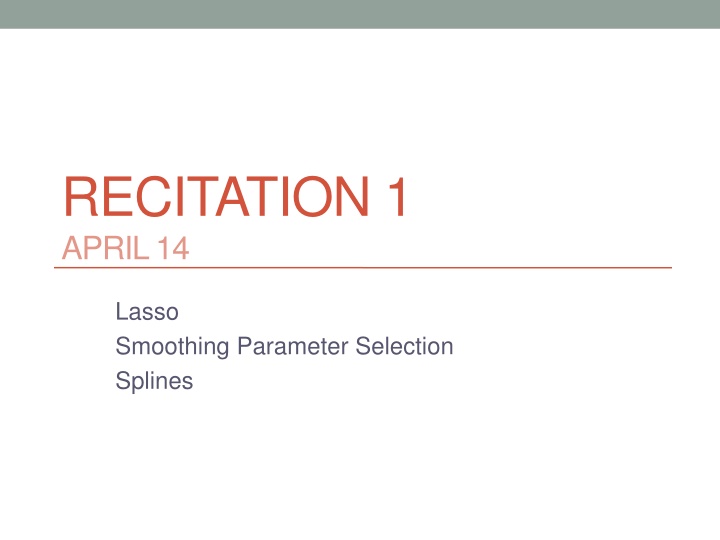
Lasso Smoothing Parameter Selection and Splines
Explore the intricacies of lasso smoothing parameter selection, sparsity intuition, solution paths, and piecewise polynomials/splines in data modeling. Learn about various techniques like leave-one-out cross-validation, regression splines, and smoothing splines for effective model building. Discover how natural cubic splines play a vital role in data approximation.
Download Presentation

Please find below an Image/Link to download the presentation.
The content on the website is provided AS IS for your information and personal use only. It may not be sold, licensed, or shared on other websites without obtaining consent from the author. If you encounter any issues during the download, it is possible that the publisher has removed the file from their server.
You are allowed to download the files provided on this website for personal or commercial use, subject to the condition that they are used lawfully. All files are the property of their respective owners.
The content on the website is provided AS IS for your information and personal use only. It may not be sold, licensed, or shared on other websites without obtaining consent from the author.
E N D
Presentation Transcript
RECITATION 1 APRIL 14 Lasso Smoothing Parameter Selection Splines
Lasso R package l1ce() in library( lasso2 ) or lars() in library( lars ) l1ce( y ~ . , data = dataset, bound = shrinkage.factor) Lasso doesn t have EDF (why?) . We can use the shrinkage factor to get a sense of the penalty.
Lasso from sketch Shooting algorithm (stochastic gradient descent) At each iteration, randomly sample one dimension j, and update How to deal with intercept Center x and y Standardize x Tuning parameter Shrinkage factor for a given Convergence criterion
Smoothing Parameter Selection In data-rich settings, use training/validation/test sets for building models/selecting smoothing parameters/calculating prediction error. Most situations are data-scarce, use approximations. 1) Leave-one-out Cross validation (n-fold CV) 2) K-fold Cross Validation 3) Generalized Cross Validation 4) Mallows Cp (not discussing)
Piecewise Polynomials/Splines Polynomials are good locally not globally. Piecewise polynomials use this to model data locally in many regions (governed by knots) to approx. global fit. Two main types of Splines: 1) Regression Splines 2) Smoothing Splines
Piecewise Polynomials/Splines Regression Splines = (# of knots) < (# of data points) No regularization, fit by LS, nice linear smoother properties But what order do we choose (linear, quadratic, cubic?) How many knots and where to place them? Hard questions!
Piecewise Polynomials/Splines Smoothing Splines: Minimizing above quantity (for any function f(x)), leads to f(x) having a functional form of a NATURAL cubic spline w/ knots at every data point. Natural cubic splines: Cubic regression splines (as talked about before + imposing linearity beyond the leftmost/rightmost knots). The Nj basis functions are derived from the cubic regression spline basis functions.
HW Tips Follow Recitation code, if relevant Plot coefficients scaled (for RR and Lasso) For the shooting algorithm, utilize the WHILE loop when running it with a convergence criterion. Check your algorithm by using the lars() function in R. For the convergence criteria, make sure you take into account the history of beta updates and/or RSS updates. (Note: | beta_(l) beta_(l-1) | < TOL probably won t cut it).
